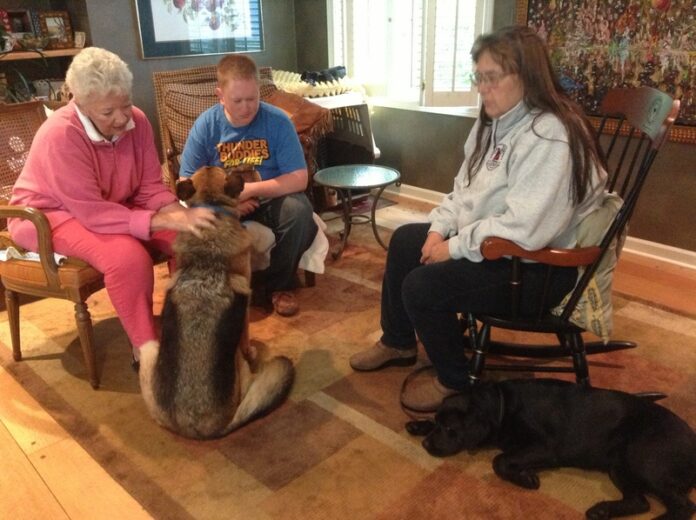
By Fran Jewell
This is probably one of the biggest problems people come to me with. I think of jumping as an invasion of my personal space and lack of respect from the dog, at ANY age. It is not “attention seeking” or “just being friendly.”
The bottom line is that the dog has not learned some basic respect and that people are the leaders. I also see jumping up as the dog’s attempt to get “higher.” Dogs are literalists. In their world, the “higher you are, the higher you are in social status.” This is why, so many times, when dogs greet each other, one dog will try to stand on the other’s shoulders or back. Do you have any friends with little dogs (especially terriers) that run to the back of the sofa when you come in the door, then they start to bark at you? This pup may be really friendly, but friendly doesn’t mean he respects people. The same can be true for other dogs, too.
It is critical to realize that larger breed dogs that do not learn to respect you both physically and emotionally as a young puppy will almost always learn to use their bodies as adults to push you around and get what they want. THIS has incredibly dangerous consequences for people!
Many people have hidden disabilities that can cause them balance problems. When you take your dog into pubic or invite people to your home, you also take the risk that you will come into contact with someone with a disability. A dog jumping (even small dogs) on someone who has a balance issue can cause them to fall and severely injure themselves, which becomes your liability. When you take your dog out in public, or even on walks in the woods, you don’t have choices about who your dog is going to meet and potentially jump on. This behavior is not just an annoyance, it literally could be a life-and-death situation for someone that the dog jumps on. It is NOT CUTE or AFFECTIONATE or being FRIENDLY.
Calling this “attention seeking” minimizes the seriousness of it and reduces our personal responsibility to train our dogs. I see jumping as a mortal sin, almost as serious as biting because it can be so dangerous.
I know this is not a popular way to view jumping, but I have a special view into this behavior, since I train service dogs for the disabled and I myself have been disabled. I see day after day the danger it poses.
Jumping on people is not only dangerous but, as I see it, is a lack of leadership in the household. A good instructor will help you recognize IF your dog is lacking respect, in general, but also how to go about gaining that respect in a way that the dog understands. Beating a dog up is not how to gain respect. It is about requiring manners on a daily basis. How you go about that may be different for each dog, depending on what is meaningful to the dog.
There are exercises that you can learn that encourage respect from the dog on many levels, and will help the dog naturally have respect, not just at the moment of jumping.
The longer you wait to teach your dog NOT TO JUMP, the harder it is to stop this very dangerous behavior. Puppies should be learning this respect for you and others the moment they come home. Explain to your friends and visitors that petting a jumping dog is simply not allowed in your household.
First, always reward sitting with LOADS OF AFFECTION! Teach sitting nicely for petting. Then, NEVER PET a jumping dog or puppy, especially one that belongs to someone else that is trying to train them. One pet for jumping signals to the dog that this is a good behavior and to do it again. Never encourage jumping for anything.
I encourage people (both on someone standing and on someone who is sitting) to “reclaim” their personal space from the dog by stepping into the dog. Most people are capable of doing this. It doesn’t require a lot of timing, but does require that the person have some confidence to just keep walking into the dog when he jumps. This is not a knee in the chest—it is reclaiming your personal space. Even after the dog gets off, walk a few steps right into him until he moves away willingly. That movement of the dog away from the person tells the person that the dog has finally respected the human’s space.
If you are in a sitting position and the dog puts his feet on you, you can simply stand up and walk into the dog. Again, this says to the dog that he has invaded your space and he must yield to you. I also use the command “GET OFF,” or just “OFF,” not “DOWN.” If you use “DOWN,” then try to teach the dog “DOWN,” your dog will be very confused.
In short, jumping is NOT a behavior to encourage for anything. It is simply dangerous and does not teach a dog to be respectful. To motivate yourself, think about how lovely it is to have clean clothes, and no scratches on your arms or legs! Starting the second you bring your dog home, puppy or older, is imperative to make the training much easier. It will help an older dog or rescue make the transition to your home easier, too, because they will learn what is acceptable and what is not.
Fran Jewell is an IAABC Certified Dog Behavior Consultant, NADOI Certified Instructor and the owner of Positive Puppy Dog Training, LLC in Sun Valley. For more information, visit positivepuppy.com or call 208-578-1565.


